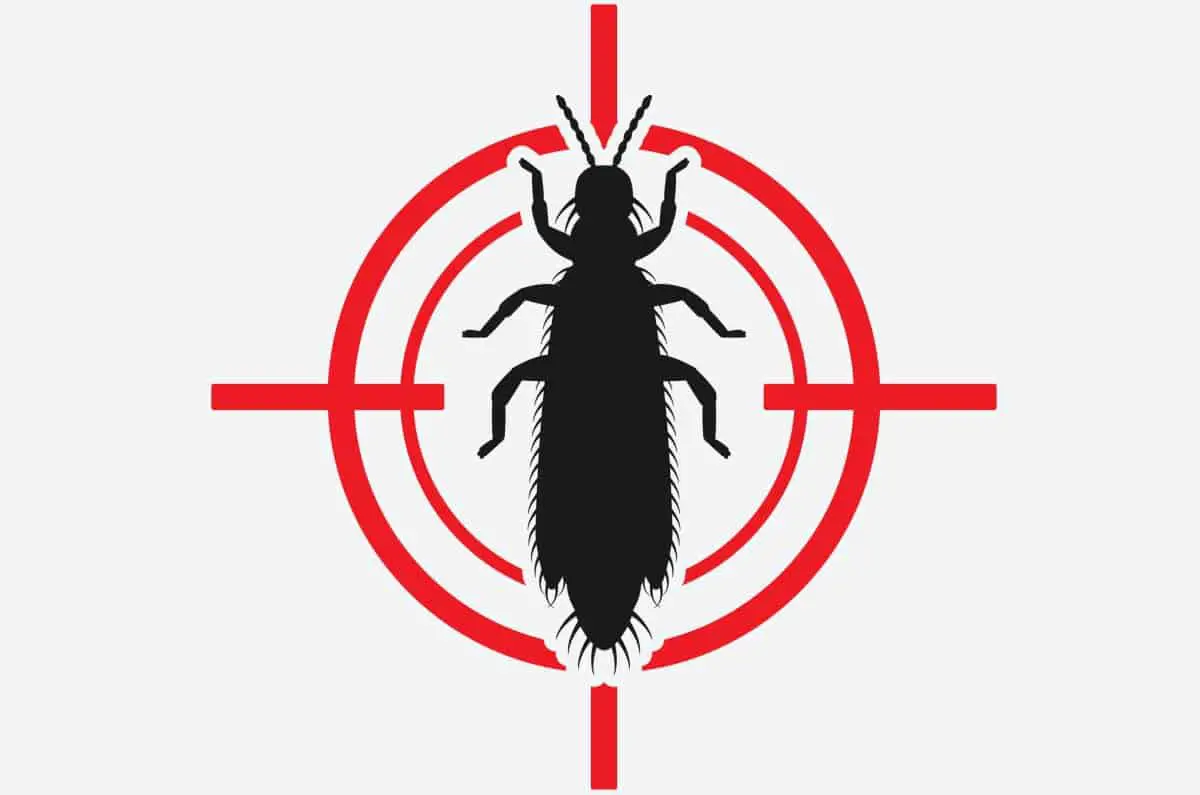Even though yuccas are relatively resilient and easy to grow, some pests will attack them. Noticing bugs on your yucca is an indication that your yucca may be in trouble. Do your research to learn what the bug is and how to treat your yucca before the pest kills it.
The most common bugs that will infect yucca plants include:
- Yucca Weevil
- Mealybugs
- Spider Mites
- Yucca Bug
- Aphids
- Thrips
These pests commonly infect the leaves and parts of the plant above the ground.
The moment you notice that something may be attacking your yucca, it is time to jump into action. First, you need to know what the bug is and how to get rid of them. Knowing when and how to quarantine an infected plant is also important. Here, we will discuss a variety of insects that attack yucca and how you can deal with them.
Identifying Common Yucca Pests.
Before you can treat your yuccas, you need to know what type of bug you are dealing with.Like the Yucca Weevil, some are specific to the yucca and will kill the plant if it becomes infested.
Each of these insects poses a threat to your yucca. This is why it is so important to learn how to identify the insect, or signs of insects on your yucca.
What are Yucca Weevils?
The Yucca Weevil, also known as Sycophorus Yuccae, is a voracious beetle that will kill the yucca and disrupt certain yucca plants’ reproduction.
Please note that these beetles are often referred to as Agave snout weevils. The Yucca Weevil and Agave weevil are two different types of snout nosed weevils. They are both very similar in appearance and can infect yucca plants. The main difference is the yucca weevil can fly, whereas the agave does not have wings.
Hey, you’ll like this one too: Do Yuccas Die After Flowering
What Does the Yucca Weevil Look Like?
The Yucca Weevil is a large flying beetle. As an adult, the yucca weevil measures around half an inch in length. They have a small head and a long snout-like mouth. These weevils have wings and can fly.
Yucca Weevils are typically noticed on plants in the late winter months and summer.
The adults will reside on lower parts of the plant but reproduce and feed at the base of the yucca flower stalk. The larvae of the yucca beetle can be up to an inch in length. They are smooth in texture and white in coloration.
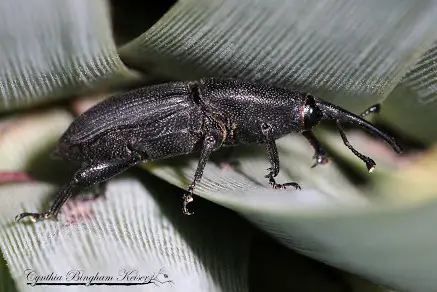
What Does the Yucca Weevil Do to Yucca Plants?
Adult yucca weevils will feed on the sap of the yucca plant. This causes the foliage to become discolored. Foliage may also exhibit small holes. The female yucca weevil will bore into the base of the yucca to lay her eggs. Once the eggs hatch, the larvae devour the yucca from the inside – out.
If you notice brown spots and holes on the leaves of your yucca, it is time to jump into action. Inspect your plant closely. Once the weevils bore into the yucca, they leave traces of bacteria on the plants. This bacterium infects the plant and causes rotting. This will kill the yucca if the larvae don’t.
How Do You Get Rid of Yucca Weevils?
Your first line of defense is always prevention. Inspect your yucca plants frequently. Take the time to clean off the yucca leaves and inspect the entire plant for any signs of insects or stress. A yucca weevil can be killed by removing it from the plant and squishing it.
As noted above, the adult yucca weevil is relatively large, and you will find them low on the plant and near its center. They may also be noticed on the leaves or at the base of the flower stalk. Check for boreholes in the stalk, or center of the plant.
If you are seeing damage to the center of your yucca this indicates the weevils have already begun drilling into the plant and laying eggs. This results in an infestation. Sadly, if your yucca is infested with the yucca beetle or the agave beetle, there is little you can do aside from removing and destroying the infected plant.
You must remove the entire infested plant, including the roots. Next, remove all of the soil around the roots and under the yucca. You will want to bag the yucca and dirt, making it as air-tight as possible. Remove the bagged yucca and dirt from your garden immediately.
If your plants are indoor only, the chances of the yucca beetle infesting are relatively low. However, a young plant bought at a nursery may harbor eggs and larvae in its soils. Use preventative measures to protect your yucca plants.
Before you put your new yucca with your other healthy plants,
- Remove it from its pot.
- Discard the soil in the pot
- Clean the pot well with soap and water.
- Rinse the roots of the yucca very well with fresh running water.
Replant your new yucca in a clean pot that will accommodate it well with room to grow. Make sure you use the appropriate potting soil mix..
Hey, you’ll like this one too: What Soil is Best for a Yucca
What Are Scale Bugs on Yucca?
Scale bugs may not be recognized as a bug by an inexperienced gardener. This is because they don’t look like a bug at first glance. There are three types of scale bugs. These are
- Mealybugs will resemble a white, cottony growth on the plant’s leaves. This fluffy looking stuff is both the egg sacks and the insects themselves.
- Armored Scale bugs look like hard growths on your plant. They may even look like new growth starting on your plant. They can be scraped from the plant and reveal a small bug within the hardcover.
- Soft Scale bugs look like small, scaly, discolored bumps on the leaves of the yucca.
Scale bugs are relatively small. They do not move around much and can be a bit startling when they do. Because they are so good at mimicking things other than the insect that they are, colonization of these bugs are easily missed before infestation.
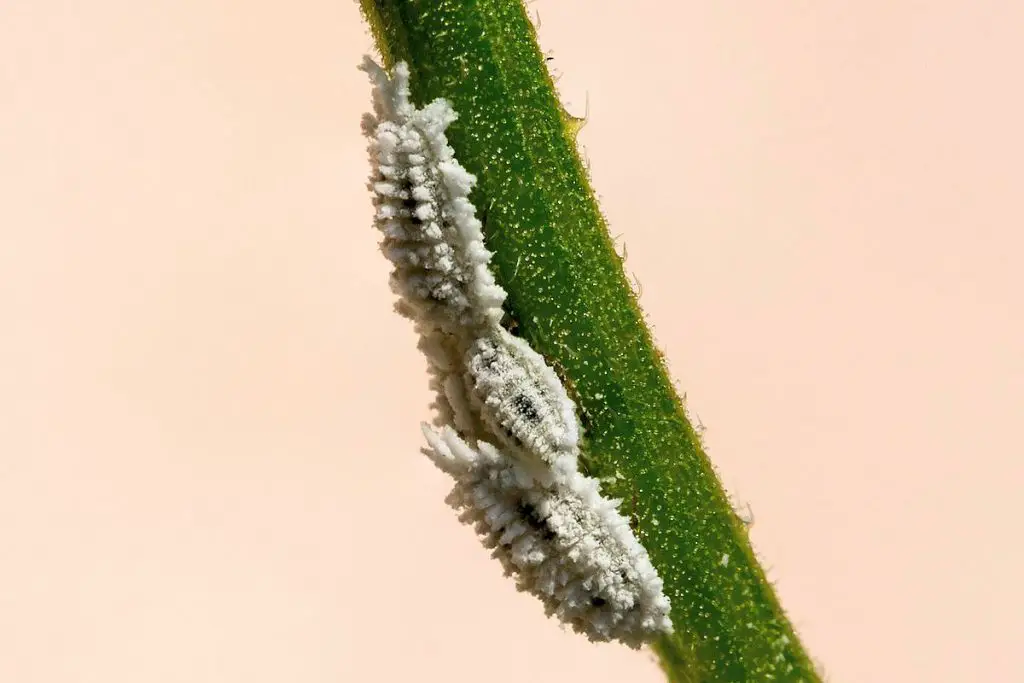
What Do Scale Bugs Do to Yucca?
Scale bugs are sap succors. They will feed off of the fluids traveling through your plant. If the infestation becomes severe, the scale bugs can kill the yucca. Scale bugs are common in house plants, but they are also found on outdoor foliage. They are easily transmissible to other plants near them.
Can a Yucca Get Spider Mites?
Spider mites can invade yuccas. Spider mites are tiny and are related to spiders. There are many varieties of spider mites. They like dry and dusty conditions, though they have been seen in tropical areas. These fuzzy web weavers can wreak havoc on your yucca and other plants.
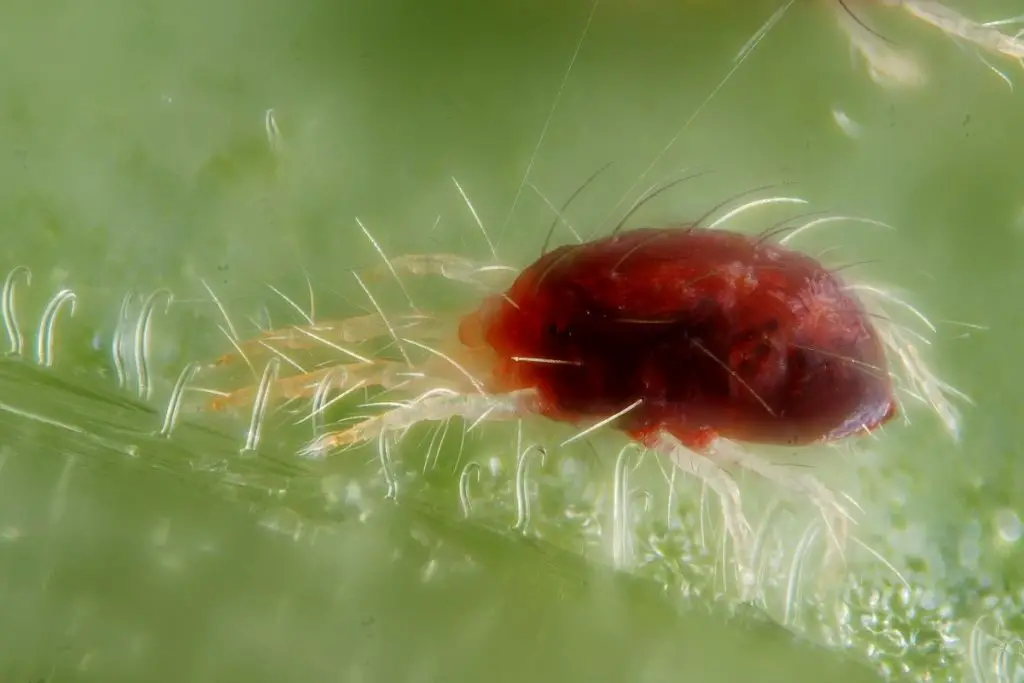
What Do Spider Mites Do to Yucca?
Spider mites eat your plants by sucking the fluids in the cell walls of the leaves. They will leave a fine spider-like webbing all over the leaves they feed on. In addition, the leaves will become discolored where they have been punctured.
The discoloration will expand until the leaf is eventually sucked dry and falls off the plant. An infestation of spider mites can kill a plant quickly.
What are the Red Bugs on My Yucca?
Red Bugs on yucca may be the Yucca Bug. They are named for the plant they love to invade. Yucca bugs go through multiple stages of development. They are oval. Adults have an orange or red:
- Thorax
- Legs
- Head
- abdomen
The nymphs are predominantly red.
What Do Yucca Bugs Do to Yucca?
The yucca plant bug feeds on the yucca by piercing the leaves and sucking the juices. They also lay their eggs inside the leaves of the eggs. They will also feed on the yucca’s flower stems, which can result in lowered flower production.
An infestation can happen quickly as they are fast to reproduce. The leaves and flower stem of yucca will show signs of damage. They will be spotted with puncture sites. The leaves will fade from their true color to a lighter color with yellowing.
Hey, read this one too: What is a Yucca Moth
Does My Yucca Have Aphids?
Aphids may be difficult to see, but they have a symbiotic relationship with ants. If the yucca suddenly has ants, look for these tiny insects that measure just 2 to 4 millimeters. Aphids are pear-shaped and come in a variety of colors such as:
- Green
- Brown
- Gray
- Red
- Black
Aphids can be a nuisance to your yucca and most other plants. They have a three-stage life cycle, making it difficult to eliminate them. As adults, aphids develop wings and can fly to new host plants.
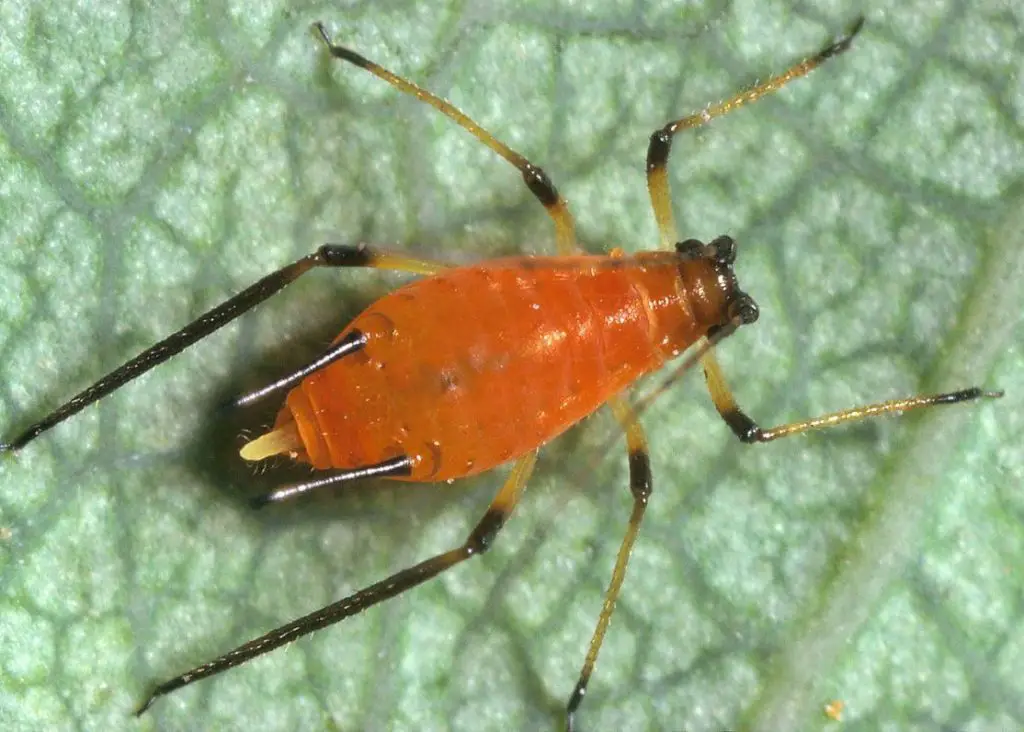
What Will Aphids Do To Yucca?
Like most insects listed here, aphids suck the vital juices from the yucca. Most of the time, you will not be able to see damage to the plant. However, it is possible to have so many of them that the leaves may show browning. The flower stalks will show much of the damage and will produce fewer flowers.
As the aphids sip the sap from the yucca, they leave behind honeydew. It is a sugary substance that attracts ants and other insects that crave sugar. Ants will farm aphids to collect the honeydew. Seeing heavy ant traffic on your yucca or any other plants nearby is a strong indicator that aphids are present.
The honeydew may cause sooty mold to develop on your yucca. Sooty mold isn’t usually too much of a problem, though it can interfere with the yucca’s ability to absorb sunlight. It is also not attractive on the plant. Clean the leaves often with a soft, damp cloth to help keep the sooty mold at bay.
What Are Black Bugs on Yucca Plants?
Thrips are a type of black bug that can infest your yucca. They are tiny and skinny. Thrips may cause damage to your plants by drinking the liquid out of the leaves. If too many are present, they may cause your yucca to wither. These little creatures may be more annoying to humans than plants because they can bite and cause irritation.
How to Prevent Bugs on a Yucca?
Prevention is the best measure of defense against bugs on yucca. Keep yucca plants in optimal health by not stressing them. Keep them in the right soil and in a place that gets sun.
Yuccas do not tolerate over watering or boggy soils. A stressed plant is an invitation to pests.
Before buying them from a nursery, inspect yucca plants to ensure they do not have a bug infestation or disease. Change the soil the plant came in and thoroughly rinse the plant and its roots before repotting or replanting. Keep the new plants separated from your other plants for a little while.
The moment you notice parasitic bugs on your yucca or other plants, you need to take steps to get rid of them. If your plants are in pots, you can do this by quarantining the yucca with the bug infestation. This can be done simply by moving the affected plant to another location away from other plants.
How Do You Get Rid of Bugs on Outdoor Yucca?
Prevention again is the best method. For outdoor yucca plants in the ground, you should inspect them often for any signs of harmful insects. You should also encourage beneficial insects to frequent your garden area.
Here’s a short list of some beneficial garden insects.
- Praying Mantis
- Lady Bugs
- Spiders
- Green Lacewing
If you notice plant eating insects on your outdoor yucca, protect other, healthy yucca in the garden by creating barriers with fine mesh netting. This netting can also be used to cover indoor and outdoor potted plants.
After you have separated your plants, you should move on to treatment. Through inspection, determine the type of insect and how bad the infestation is. Depending on the type of insect, you may be able to remove a lot of the insects by gently cleaning your plant using a soft washcloth dampened with water.
Just be sure to remove the washcloth and clean the cloth with soap immediately after wiping the yucca down.
Treating your yucca for bug infestation may be as simple as rinsing them off often or as painful as having to destroy a beloved yucca such as one that has yucca weevils. In some cases, you may need to use remedies to kill the insects. These remedies can be homemade or store bought.
What Can Be Used to Treat Bugs On Yucca?
There are a few remedies that kill many plant attacking insects. One treatment will not be enough, because these often do not kill the eggs of the bugs. You will need to be vigilant in your inspections and treatment methods, as your battle with the bugs may continue for a very long time.
Here are some available treatments:
- Insecticidal Soap. This insecticidal soap uses potassium salts derived from plant sourced fatty acids. Shake the bottle and spray directly on the insects. Be sure to spray all over the plant and under the leaves where the bugs hide. Wait a few minutes, and then rinse your yucca with water.
- Clear Dish Soap. Add just a few drops to a spray bottle of fresh water. Spray both sides of the leaves and the rest of the plant. You should wait a few minutes to let the soap work. Then you can gently wipe the leaves down with a soft cloth or go directly to rinsing the yucca with a lot of fresh water.
- Neem Oil is an organic insecticide. It will also help with fungus and mites.
Always follow the manufacturer’s recommendations when using a pre-made insecticide or preventative on your plants. Also, be sure to test a small area on your plant no matter what you are using to ensure your plant will tolerate it.
Using natural-based insecticides is highly recommended. Like many other insects, Scale bugs have become increasingly poison resistant, while the toxins of the chemical insecticides are having an ill effect on good insects and animals that come into contact with it.
A Note About Insecticides and Pesticides
Pesticides and insecticides should be used with caution and only when necessary, because they will likely kill beneficial insects and the pest attacking your yucca. It is often possible to get rid of bugs on the yucca without using any harsh chemicals.
- A note on Rubbing Alcohol, some people suggest putting alcohol on the plant. Please do not do this. Alcohol has the potential to kill a plant. If you decide to use alcohol as an insect killer, pour some into a wide mouth jar and shake the bugs off the leaves into the jar. Some insects, such as scale bugs, will require you to scrape or rub them off. When you do this, drop them into the jar of alcohol.
Be sure to test any treatments you plan to apply to the yucca. Dab or drip a tiny spot of the treatment onto a yucca leaf to ensure that it will not do more damage than the insects are.
Know The Bugs on Your Yucca
Not all bugs are out to destroy your beautiful yucca. If your yucca is healthy, chances are there will be beneficial insects nearby or on your plant. To keep harmful insects at bay, you should keep your yucca clean and inspect it and the other plants in your garden often.

